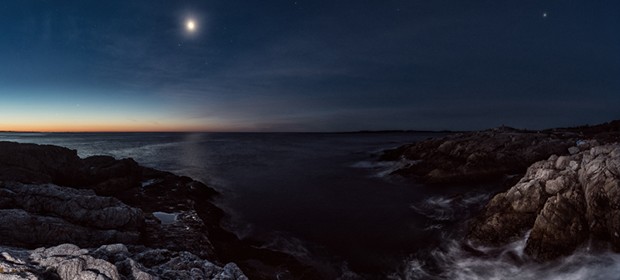Three of the major planets are wonderfully arrayed across the southern evening sky this month. Moving from west to east, they are Jupiter, Mars and Saturn—each unmistakable in their radiance and each offering features for naked-eye, binocular and telescopic observation. Following is an overview of what can be seen using each of these.
Unaided Eye:
The first thing to notice is their heavenly hues. Jupiter appears silvery white (especially when placed higher in the sky). Mars is an unmistakable reddish-orange in color. Interestingly, right now it’s placed near the bright fiery star Antares to its lower left, whose name means “rival of Mars.” Finally, Saturn looks a subtle yellowish-white. Another thing to notice is that while the stars around Jupiter, Mars and Saturn including Antares itself twinkle, the planets themselves shine with a steady light. As discussed in previous Sky Talks, this is because starlight consists of single pinpoint beams of light that are easily refracted by atmospheric turbulence. Planets on the other hand have sizeable apparent disks composed of bundles of light that average out such disturbances.
Binoculars:
Binocular having magnifications of 7X or 10X will definitely show several of Jupiter’s four bright Galilean (those discovered by Galileo) satellites, depending on where they are about the planet. This is especially so if supported or mounted in some way. They also reveal the giant planet’s non-stellar disk. Image-stabilized (IS) glasses (in the case of viewing features of all three planets) make them unmistakable. Mars also displays a non-stellar disk and looks positively on-fire! In the case of Saturn, it appears distinctly egg-shaped due to the presence of its ring system. Its big moon Titan can also be glimpsed
Telescopes:
Even the smallest of these instruments at magnifications of 25X or more will open the wonderful realm of planetary exploration to you! The Galilean satellites provide endless delight as they orbit the planet—disappearing and reappearing into and out of Jupiter’s huge shadow, passing behind the planet, or crossing in front of its cloud-streaked disk rotating disk. At magnifications of 100X or more, Mars shows fascinating surface features when close to us at opposition as it is currently. These include its white polar caps, orange deserts crossed by greenish-gray markings, bluish clouds, and occasional brown planet-wide dust storms. Saving the best for last is Saturn and its magnificent rings, the most other-worldly sight in all the heavens! The rings are evident even at 25X in a 2-inch glass and become ever-more spectacular as magnification and telescope size increase. Having Jupiter, Mars and Saturn all right before you to scrutinize at the same time on a clear summer’s night is an opportunity not to be missed!
— James Mullaney
Former assistant editor at Sky & Telescope magazine & author of nine books on stargazing. His latest, Celebrating the Universe!, is available from HayHouse.com


